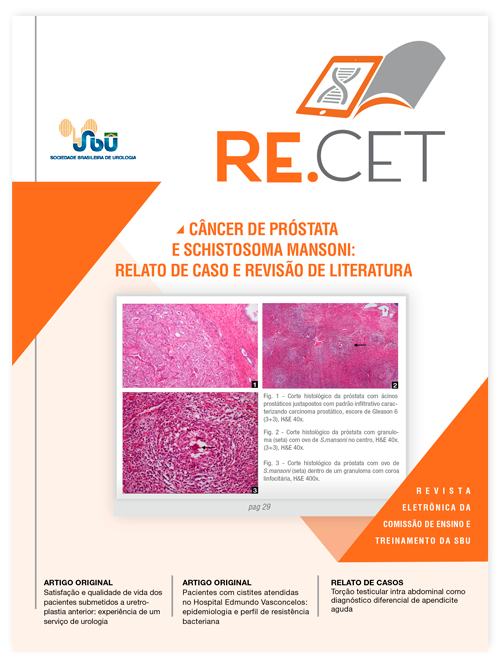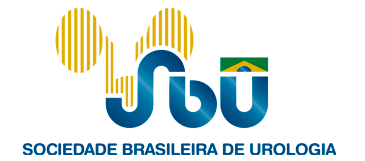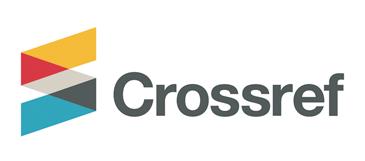Satisfação e qualidade de vida dos pacientes submetidos a uretroplastia anterior:
experiência de um serviço de urologia
Palavras-chave:
Estenose Uretral, Satisfação, Qualidade de Vida, Resultados Relatados pelo PacienteResumo
OBJETIVO: Avaliar a satisfação e a qualidade de vida pós-operatória dos pacientes e identificar se houve relação dos resultados com dados clínicos, sintomas miccionais e fluxo urinário. MÉTODO: Estudo transversal, observacional e não randomizado, de 20 pacientes submetidos a uretroplastia em um hospital público, entre 2016 a 2018. Foram colhidos dados clínico-epidemiológicos, realizado entrevista pós-operatória sobre fluxo urinário, satisfação e qualidade de vida e exame de urofluxometria. RESULTADOS: Em média, tinham 56 anos de idade e 16 meses de cirurgia. Dos participantes, 75% tinham até ensino fundamental incompleto. O comprimento médio da estenose era de 2cm. As principais causas foram: iatrogênica (35%), traumática (35%) e infecciosa (25%). As técnicas utilizadas foram término-terminal (65%) e com enxerto de mucosa oral (35%). No momento da entrevista, 55% dos pacientes apresentavam sintomas urinários leves e 25%, graves. Sobre a satisfação, 70,0% se consideraram “Muito Satisfeito ou Satisfeito” com o resultado da cirurgia. Foi encontrado efeito das variáveis: etiologia, tempo, técnica cirúrgica, sintomas urinários, jato urinário e interferências dos sintomas sobre a satisfação e a qualidade de vida. CONCLUSÃO: A maioria dos pacientes ficou satisfeito com o resultado cirúrgico e houve diferença no grau de satisfaçao e qualidade de vida a depender da etiologia, técnica cirúrgica e tempo de cirurgia.
Referências
2. Erickson BA, Ghareeb GM. Definition of Successful Treatment and Optimal Follow-up after Urethral Reconstruction for Urethral Stricture Disease. The Urologic clinics of North America. 2017;44(1):1-9. Available from: https://www.ncbi.nlm.nih.gov/pubmed/27908363.
3. Jackson MJ, Sciberras J, Mangera A, Brett A, Watkin N, N'Dow J M, et al. Defining a patient-reported outcome measure for urethral stricture surgery. European urology. 2011;60(1):60-8. Available from: https://www.ncbi.nlm.nih.gov/pubmed/21419566.
4. Barbagli G, Montorsi F, Balo S, Sansalone S, Loreto C, Butnaru D, et al. Treatments of 1242 bulbar urethral strictures: multivariable statistical analysis of results. World journal of urology. 2019;37(6):1165-71. Available from: https://www.ncbi.nlm.nih.gov/pubmed/30220045.
5. Voelzke BB. Critical review of existing patient reported outcome measures after male anterior urethroplasty. The Journal of urology. 2013;189(1):182-8. Available from: https://www.ncbi.nlm.nih.gov/pubmed/23174257.
6. Lucas ET, Koff WJ, Rosito TE, Berger M, Bortolini T, Neto BS. Assessment of satisfaction and Quality of Life using self -reported questionnaires after urethroplasty: a prospective analysis. International braz j urol : official journal of the Brazilian Society of Urology. 2017;43(2):304-10. Available from: http://www.ncbi.nlm.nih.gov/pubmed/28128915.
7. D'Ancona CAL. Avaliação Urodinâmica e suas Aplicações Clínicas2015. 375 p.
8. Jackson MJ, Chaudhury I, Mangera A, Brett A, Watkin N, Chapple CR, et al. A prospective patient-centred evaluation of urethroplasty for anterior urethral stricture using a validated patient-reported outcome measure. European urology. 2013;64(5):777-82. Available from: https://www.ncbi.nlm.nih.gov/pubmed/23664422.
9. Peeling WB. Diagnostic assessment of benign prostatic hyperplasia. Prostate Suppl. 1989;2:51-68. Available from: https://www.ncbi.nlm.nih.gov/pubmed/2482773.
10. EuroQol G. EuroQol--a new facility for the measurement of health-related quality of life. Health policy. 1990;16(3):199-208. Available from: http://www.ncbi.nlm.nih.gov/pubmed/10109801.
11. Santos M, Cintra MA, Monteiro AL, Santos B, Gusmao-Filho F, Andrade MV, et al. Brazilian Valuation of EQ-5D-3L Health States: Results from a Saturation Study. Med Decis Making. 2016;36(2):253-63. Available from: https://www.ncbi.nlm.nih.gov/pubmed/26492896.
12. Kessler TM, Fisch M, Heitz M, Olianas R, Schreiter F. Patient satisfaction with the outcome of surgery for urethral stricture. The Journal of urology. 2002;167(6):2507-11. Available from: https://www.ncbi.nlm.nih.gov/pubmed/11992068.
13. Barbagli G, Romano G, Sansalone S, Lazzeri M. [Italian validation of the English PROM-USS-Q questionnaire in patients undergoing anterior urethroplasty]. Urologia. 2011;78(2):98-107. Available from: https://www.ncbi.nlm.nih.gov/pubmed/21574144.
14. Kluth LA, Dahlem R, Becker A, Schmid M, Soave A, Rosenbaum C, et al. Psychometric validation of a German language version of a PROM for urethral stricture surgery and preliminary testing of supplementary ED and UI constructs. World journal of urology. 2016;34(3):369-75. Available from: https://www.ncbi.nlm.nih.gov/pubmed/26049865.
15. Santucci RA, Joyce GF, Wise M. Male urethral stricture disease. The Journal of urology. 2007;177(5):1667-74. Available from: http://www.ncbi.nlm.nih.gov/pubmed/17437780.
16. Gallegos MA, Santucci RA. Advances in urethral stricture management. F1000Research. 2016;5:2913. Available from: http://www.ncbi.nlm.nih.gov/pubmed/28105329.
17. Kinnaird AS, Levine MA, Ambati D, Zorn JD, Rourke KF. Stricture length and etiology as preoperative independent predictors of recurrence after urethroplasty: A multivariate analysis of 604 urethroplasties. Canadian Urological Association journal = Journal de l'Association des urologues du Canada. 2014;8(5-6):E296-300. Available from: https://www.ncbi.nlm.nih.gov/pubmed/24940453.
18. Erickson BA, Breyer BN, McAninch JW. Changes in uroflowmetry maximum flow rates after urethral reconstructive surgery as a means to predict for stricture recurrence. The Journal of urology. 2011;186(5):1934-7. Available from: https://www.ncbi.nlm.nih.gov/pubmed/21944128.
19. Heyns CF, Marais DC. Prospective evaluation of the American Urological Association symptom index and peak urinary flow rate for the followup of men with known urethral stricture disease. The Journal of urology. 2002;168(5):2051-4. Available from: https://www.ncbi.nlm.nih.gov/pubmed/12394706.
20. Comes Y, Trindade Jde S, Shimizu HE, Hamann EM, Bargioni F, Ramirez L, et al. Evaluation of user satisfaction and service responsiveness in municipalities enrolled in the Mais Medicos (More Doctors) Program. Ciencia & saude coletiva. 2016;21(9):2749-59. Available from: https://www.ncbi.nlm.nih.gov/pubmed/27653060.
21. Morey AF, McAninch JW, Duckett CP, Rogers RS. American Urological Association symptom index in the assessment of urethroplasty outcomes. The Journal of urology. 1998;159(4):1192-4. Available from: http://www.ncbi.nlm.nih.gov/pubmed/9507830.
22. Tam CA, Elliott SP, Voelzke BB, Myers JB, Vanni AJ, Breyer BN, et al. The International Prostate Symptom Score (IPSS) Is an Inadequate Tool to Screen for Urethral Stricture Recurrence After Anterior Urethroplasty. Urology. 2016;95:197-201. Available from: http://www.ncbi.nlm.nih.gov/pubmed/27109599.
23. Tam CA, Voelzke BB, Elliott SP, Myers JB, McClung CD, Vanni AJ, et al. Critical Analysis of the Use of Uroflowmetry for Urethral Stricture Disease Surveillance. Urology. 2016;91:197-202. Available from: https://www.ncbi.nlm.nih.gov/pubmed/26873640.
Downloads
Publicado
Como Citar
Edição
Seção
Licença
Copyright (c) 2025 Recet

Este trabalho está licenciado sob uma licença Creative Commons Attribution-NonCommercial 4.0 International License.









